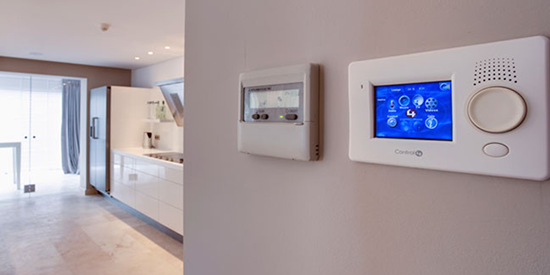A Beginners Guide to Home Automation


Four Steps to a Smarter House
Guest Article by David Glenn
Welcome to the future. As technology becomes smaller, easier to produce, and about as ubiquitous as oxygen, humanity is discovering that it can be put to good use controlling various systems around the home. Lighting, climate control, door locks, security, and entertainment can all be connected and automated, thus turning your dumb-old dwelling into an effort saving smart home. However, the dream of being able to wake up to an already brewing pot of coffee, or to have a thermostat that knows to turn itself off when you leave the house takes a bit of know-how before it can be fully realized. After all, those various appliances and devices aren’t going to automate themselves. So, to help you help your house help you, here are four steps to a smarter home.
1. Have a plan: DIY or a Full-blown System
First and foremost, you need to decide exactly what it is that you want your home to be able to do, and how much you’re willing to spend to get it there. After all, “home automation” is an umbrella term that encompasses a wide variety of tasks and devices. If you’re going to commit to it, then you need to understand your options. If you want an entire package and don’t mind paying a bit more for it, you can always contact a home automation provider, such as Vivint and Nest. For your money you’ll get a complete automation system professionally installed, and will have access to trained technicians should any problems arise. However, there’s nothing wrong with a little DIY—especially if you want to save some money. Sit down and make a list of all of the things that you want to be able to do with your home automation system, and number them in order of importance. This way, if you find that you’re running out of funds before you get to everything, then you’ll at least have the highest priority systems taken care of.
2. Choose a Standard
If you want your devices to be able to easily communicate with one another and work seamlessly together (which isn’t actually vital to home automation, given that you can simplify the entire process by purchasing specialized boxes that connect directly into electrical outlets and allow you to put devices on timers), you’ll need to decide upon a standard. X10 and Insteon are both fine for basic home automation. These two systems are most popular for home automation beginners will get the job done. Both Zigbee and Z-Wave are also useful systems as you progress into a more connected and advanced smart home. Many have compared the latter two systems to the usability of a Mac and a PC—both are useful and effective in their own ways, but some users prefer one over the other. It’s best to do your research before investing in a system that will be best for your needs.
3. Install Home Automation Systems One at a Time
Home automation can be incredibly complex and, as is the case with any complex system, there is a high probability of something going wrong. If you’re installing your own systems, make sure to take your time and do it right. Follow the instructions closely, and don’t try to take on too many home automation projects all at once. Instead, approach the installation process one system at a time, and make sure that everything is functioning properly before you move on. If you do encounter problems, be sure to double check all of your electrical connections, and remember that most devices will have a troubleshooting guide or direct customer assistance option available online. If you take your time and get it right, then you won’t have to go back to square one just to see what went wrong.
4. Secure Your Smart Home
Once you’ve got everything set up and working, you’re not done yet. What you have done is essentially turn your home into a big computer, and computers rely on software that needs to remain up-to-date in order to function safely and properly. Be sure to keep up with any software patches that may be released for your systems, and remember—if you can access your home devices wirelessly and remotely, then so can others. Be sure to make use of any security features that are available for your specific systems (such as password protection), and keep informed as to any new threats or solutions as they arise.
There are any number of ways that you can use modern technology to automate your home, and new possibilities are opening up every day, so hop on the internet, read some reviews, and see what direction is best for you. After all, we’d all like to have a house that’s smart enough to make our lives easier, but if you’re not careful then getting there can be a real pain in the foundation.
Recent Posts
Framing Stick Nailer vs Coil Nailer
Which is Better a Stick Nailer or Coil Nailer? Framers have many choices in nailers…
How Many Roofing Nails Per Square of Shingles
Estimating How Many Nails for a New Roof When it comes to estimating materials for…
Composite / PVC Decking – Layout Tips & Advice
Composite / PVC Decking Layout Tips and Advice Composite and PVC decking have really changed…
Benefits of an ERV System (Energy Recovery Ventilator)
Benefits of ERV Systems (Energy Recovery Ventilator) If you're building a new home or doing…
Vermiculite Attic Insulation Abatement
Vermiculite Attic Insulation If your home was built before 1990 there is a chance it…
Nuisance Tripping of AFCI (Arc Fault) Circuit Breakers
Arc Fault (AFCI) Circuit Breakers Tripping Often An arc-fault circuit interrupter (AFCI) or arc-fault detection…

